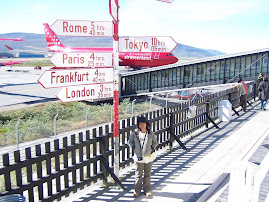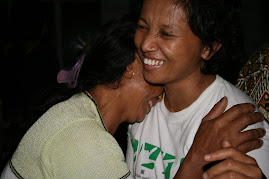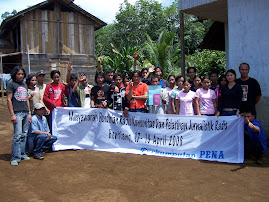Dayak folk-healing yields to modern cures
The Jakartapost, Features - September 27, 2002
Erma S. Ranik, Contributor, Pontianak, West Kalimantan
The cold was gripping in Sikukng mountain range area, Jagoi Babang district, Bengkayang regency. The clock struck 11 -- a time when everyone in the village goes to bed.
In Batu Ampar village, however, Magang and his daughter were still busy. He was chanting prayers while his eight-year-old daughter played a bracelet-like music instrument to accompany the prayers.
In fact Magang was not reciting prayers; he was trying to heal a sick child. He is a baliatn (healer), for the Dayak Sikukng tribe. When trying to heal his patients, he usually stays awake until 2 a.m. Only when the tribal rite has been completed, he will return to his home and take a rest. Then if someone else needs his help, he will not reject them.
"It's taboo for me to refuse the request of someone who needs my help," he said softly.
Magang is not alone. In other Dayak villages there are quite a few who have the same profession. They are unique, as modernization pushes itself into the lives of the Dayak people.
This profession has many names. For the Dayak Simpakng, this healer is called a Boretn. The Dayak Jalai call him a Baliatn. Among the Dayak Kemayo people, he is known as a tabib, while the Dayak Ketungau Sesat call him a Manang.
Before the Dayak people were familiar with modern medicine, a baliatn was the only form of healing for them. They would go to a baliatn for all physical complaints and if they were possessed by an evil spirit.
Does a baliatn heal the sick more effectively than a modern physician? It all depends on your conviction.
Customary chief (Timanggokng) Maniamas Miden, however, has testified about the magic power of a healer called Susun of Sidik Tajur village, in Landak regency.
"When he heals a patient, he will cut the patient's skin with a knife. Then he reads a magic incantation and covers the wounded skin with a white cloth. He strokes this part gently and then he removes the cloth. Surprisingly, you cannot see any scar," said Miden.
Munying, a healer from Tanjung village, Ketapang regency, also has a unique way of healing his patients. Sometimes he extracts strange objects from the body of his patient, such as needles, stones and hair. This healer enjoys a respectable position in his community. The Dayak people believe he possesses supernatural powers and therefore accord him with an important and sacred position.
To be a baliatn is a vocation and is one that is not easy to fulfill. First, you must have the right lineage. For the Dayak Ketungau Sesat in Sekadau district, you can only be a healer if either your father or your mother is a healer.
Usually, there are several signs that show that a person can be a healer. He or she can see and communicate with spiritual beings and can see the causes, as well as, the cure for an illness. Then, he or she must take lessons from a senior healer.
When someone is initiated as a healer, they take a vow that he or she will be a healer for the rest of their lives. However, there are sub-tribes that allow a healer to retract his or her vow, for example, the sub-tribe of Dayak Ketungau Sesat.
This may take place if the parents have objections to their child being a healer. This rite is called the batak and is not a great occasion. It can be conducted at the same time as a rite held when a sick person is being healed. However, only senior and experienced healers can conduct the batak.
A Dayak healer is always ready to sacrifice his sleep. The healing process usually starts in the evening and will not end until the next morning. In a barayah rite of the Dayak Jalai, the healer starts the rite at 9 a.m. and ends at 9 a.m. the next day.
A healer usually has several assistants. In the Dayak Jalai sub-tribe, trainee healers will serve as assistants. It is also likely that other healers assist. A healer in Dayak Simpakng has several assistants called pabayu. They have their own duties or they may take turns singing barayah, striking the drums or playing other music instruments.
To live as a healer is not easy. Aside from the many taboos, he must also memorize hundreds of prayers or magic incantations. A Dayak Jalai healer is required to recite hundreds of prayers and mantras called petalian while healing a sick person.
The prayers are chanted, accompanied by the sound of ketabung (small drums). If you understand the language, this petalian sounds like beautiful verses read in a particular rhythm. If you listen to it at midnight or in the early hours, you will experience real serenity.
A healer must have a good knowledge of the efficacy of certain herbs and roots to be used as medicine. He or she must also learn to concoct different herbal medicines according to the needs of different patients.
Nowadays, fewer people are interested in the profession because of the difficult prerequisites. Besides, more and more Dayak people trust modern medicine more than their own traditional healing methods.
Dayak people are reluctant to become healers because of the presence of religion among them. Healers are usually considered "unreligious".
"We are often accused of worshiping idols," said Pisuq, a Dayak Jalai healer from Ketapang.
The number of healers is dwindling. In several villages, only the old healers remain. There is no regeneration. Shrinking forest areas make it difficult for these healers to find the herbs and roots for their medicinal concoctions.
Munying, for example, grows the necessary herbs near his house.
"We can't depend on nature as many forests have been converted into plantations," he said.
If Munying and other baliatn can no longer find the herbs in the forest, the traditional knowledge of the Dayak may be lost. Then, there will no longer be any healers and finally, tragically, one aspect of the Dayak culture will simply vanish.
The writer is the editor of Kalimantan Review, a media for empowerment of customary communities.






.jpg)